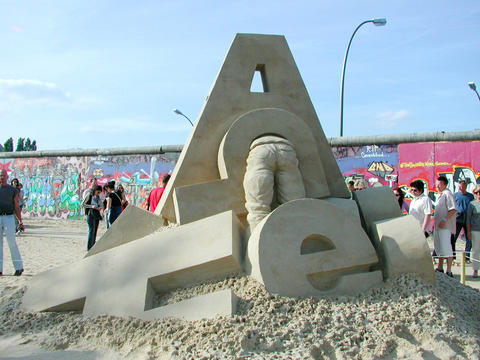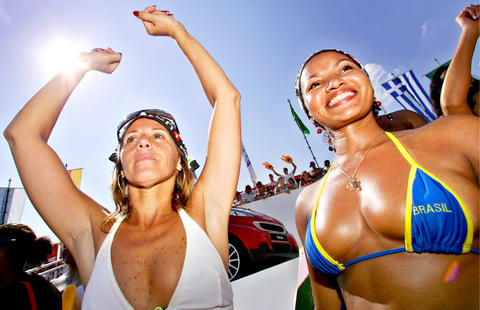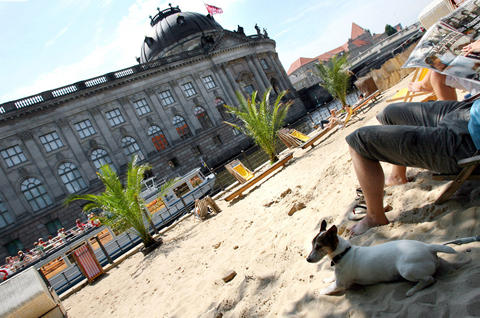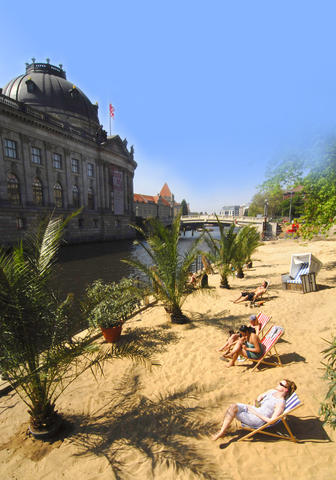I have sand between my toes, a cooling drink in my hand and as I recline on the pile of inflatable tires, I can hear trains rumble past somewhere above my head. I am in a deranged Wild West village that looks as if it has been dropped from a great height on to a beach, with potted palms and AC/DC hollering out from the DJ booth.
Before Paris got its Plage and London, Amsterdam and even Birmingham jumped on the "sandwagon," there was Berlin. A former swamp 240km from the sea, the German capital perfected inland beach culture about 95 years before other landlocked cities. And as parks and squares across Europe are hurriedly transformed into artificial beaches this summer, Berlin is really pushing the boat out.
A mongrel country-and-western style beach, bar and play area, Strandmarkt is one of 30 beaches that have sprung up in Berlin. This stretch of sand is more than a little crazy. It's almost as bonkers as taking a beach holiday in a European capital far from the coast. The only thing that isn't balmy is the weather.

PHOTOS: AFP AND COURTESY OF WWW.VISITBERLIN.DE
My Australian companion is skeptical. Australians don't need to build beaches and they don't understand those who do. Unfortunately, on our first evening in Berlin, the rain-lashed deck chairs of the first urban beach we visit - bizarrely billed as boasting wonderful views of Berlin's new railway station at sunset - look as hapless as an out-of-season English seaside resort.
The following day is also a washout. But it's here that the advantages of a holiday in a real city with fake beaches (as opposed to the usual fake city on a real beach) hit home. Our hotel's chic gray minimalism and amazing breakfasts (served until a very civilized 1pm on Sunday) are perfect for a gray day, as are Berlin's museums, most notably, Daniel Libeskind's striking, disturbing Jewish museum. Then there's the added bonus of Germany's superstar polar bear, Knut, who looks deliriously content when cool rain falls on the city's zoo.
Beach weather threatens to break out by the second evening and a stroll to Strandbar Mitte on the edge of Monbijou Park in the city center reveals why Berlin does beaches so well. Where in Britain could you arrive at 9.30pm on a Saturday and get a drink and a seat straight away? Where in Ibiza could you instantly plunk yourself on a chair right by the water? Forget the stereotypes about the race for the sun-loungers; in Berlin, there's a deck chair for everyone.

Rumpled like a trendy haircut, yet blessed with that German talent for order, Berlin boasts incredible space. Vast tracts of the city still lie in undeveloped, post-industrial ruins - the legacy of its painful cold war division. Much is the kind of desolate riverside that became London's Docklands 20 years ago. It's perfect beach-building territory.
Inland beaches probably began with the Wannseebad, a traditional lakeside bathing spot out in the suburbs beyond Berlin's Grunewald forest that celebrates its 100th anniversary this summer after a long program of refurbishment. But Strandbar Mitte was the first modern urban beach to open in the center of Berlin. It first scattered the sand in 2002 (the same year as the more celebrated Paris Plage). This summer, it offers a thick carpet of proper beach sand, palm trees and cozy Strandkorben (literally, "beach baskets"), the traditional German two-seater beach chairs.
A twentysomething crowd hunkers down against the evening chill, although the caipirinha served up at the attractive bar shack delivers a warming kick. My companion wriggles her toes on the chilly beach, perplexed. "Where I come from the sand is warm," she observes. It is, at least, scenic: swifts dart over the river Spree and the handsome walls of the Bode museum opposite are dappled with light bouncing off the water.

Strandbar Mitte is also impressively - but not oppressively - well organized. The beach toilets are clean (they always are) and all drinkers pay a deposit on their glasses and bottles, which means they return them to the bar rather than leaving them scattered in the sand. The neighboring beaches in the center of Berlin, such as Bundespresse Strand and Beach Park 61, are similarly well put together, offering drinks, music and plenty of beach volleyball (place your 2012 Olympic bets on the Germans now).
But what sets Berlin apart from other cities is its proliferation of independent beaches. Most European urban beaches are little more than overcrowded corporate stages, while many of Berlin's beaches are the summer siblings of its underground club scene.
The sun shines on Sunday, and we head for the grittier beaches on the banks of the Spree near the Ostbahnhof railway station. This is where you can relax in the Wild West chaos of Strandmarkt, devised on an old recycling center by the two men behind the cult Berlin nightclub White Trash Fast Food. One of them, Walter, is mixing a formidable Bloody Mary at the bar. What makes a great urban beach? "Three hundred tonnes of sand and a will to have a cocktail," he smirks. "The drive to sit on the beach and have a cocktail is definitely strong in Berlin." Most beachgoers here are locals who arrive on bicycles to tuck into a "hangover breakfast," play ping-pong or collapse into loungers under parasols surrounded by Wild West shacks and Chinese lanterns.

Beaches are supposed to have sand, but that hasn't stopped some - or Bar 25, next door to Strandmarkt. Tucked away behind a slice of the Berlin Wall, Bar 25 is a stretch of decking by the River Spree and a wooden bar that creaks to the thud of German techno. A glitter ball hangs from a poplar tree and lines of lights dance above. It stays open from Saturday night until Monday morning, (with more usual opening hours during the week). Shortly after midday on Sunday, its skinny jean-clad crowd looks like they will be partying well into next week.
While the odd tourist finds its door in the wall, Bar 25 remains the kind of underground club for which Berlin is famed. "At night it all becomes a little crazy and that's what we like," says Kathinka, who runs the bar area. This isn't a beach for sunning yourself and sipping expensive cocktails, although if 48-hour clubbing marathons sound too energetic, the club also shows underground movies, has a fine-dining restaurant with views across the river and plans to offer sauna and massage.
After a couple of hours in the sun, the murky waters of the Spree seem increasingly alluring. But even the hard-core clubbers of Bar 25 rarely plunge into the river. Instead, they use the Badeschiff, a huge old industrial barge converted into a swimming pool (and sauna in winter) and moored on the left bank. Beside it there is a bar, another beach and a wooden jetty, perfect for sunbathing. The pool is a 20m oblong of clear blue water on the dark waters of the Spree. Despite an entrance hidden away at the back of a maze of old tram sheds, Badeschiff is the busiest of the beaches but still perfect to bob about in on a Sunday afternoon. Serious swimmers arrive at 8am on weekdays.
Ostrand also has an old boat moored on the river for sunbathers, although this one has no pool. Surrounded by more commercial beach bar operations - such as the fancy white leather of Strandgut beach bar and the pumping techno of Space Beach - it retains a homely feel with olive trees in pots, wood-fired pizza and a good mix of twenty and thirtysomethings and young families.
Real or fake, the best kind of beach is the sort that you have to tear yourself away from at the end of the day, gritty and giddy from sunshine and the odd bottle of passion fruit beer.
Yaam beach has this effect. Set up by a social worker in 1996, Yaam is a slice of the Caribbean in Berlin - it's not a tacky themed beach, but a real focal point for some of the city's immigrant communities with hip-hop, reggae and ragga gigs as well as basketball and volleyball for the teens who hang out here. "The idea is not, 'let's have a beach and drink cocktails.' It's a youth project. We want to bring people from different backgrounds together in a harmonious way," explains Lea Varnbuler, one of Yaam's managers.
This not-for-profit beach sounds worthy, but it's as fun and sandy as a beach should be. Set behind a graffitied slab of the Berlin Wall, you can swing in a hammock overlooking the river, as the sound of reggae drifts from the bar. The cocktail list is long and cheap - mojitos and mai tais are less than US$6.90 and there is also the peculiar charm of Dju Dju, a bottled beer from Ghana that comes in mango, banana, palm or passion fruit flavors.
I'm happy in my hammock but, sadly, it can't last forever. Berlin's property boom and rapid redevelopment is squeezing out some of the best underground beaches. Mainstream beaches like Strandbar Mitte will endure, but by next summer, the only sand on the banks of the River Spree may be for the foundations of office blocks and luxury apartments.
"It's like any city - the gentrification happens at a really high pace," says White Trash's Walter. Lea Varnbuler, from Yaam, also sees clouds on the horizon. "There's a lot of art and underground lifestyles in Berlin. They still exist now, but I don't know whether they will much longer because the policy is to tidy up the city." And at Bar 25, Kathinka fears their days are numbered. "We don't know if this is going to be the last year. The owner of the property wants to sell it," she says. "We're fighting it because we think this is underground culture, which is really important for Berlin."

As I finally slid into the warm embrace of the hot, clifftop pool, it was a serene moment of reflection. The sound of the river reflected off the cave walls, the white of our camping lights reflected off the dark, shimmering surface of the water, and I reflected on how fortunate I was to be here. After all, the beautiful walk through narrow canyons that had brought us here had been inaccessible for five years — and will be again soon. The day had started at the Huisun Forest Area (惠蓀林場), at the end of Nantou County Route 80, north and east

Specialty sandwiches loaded with the contents of an entire charcuterie board, overflowing with sauces, creams and all manner of creative add-ons, is perhaps one of the biggest global food trends of this year. From London to New York, lines form down the block for mortadella, burrata, pistachio and more stuffed between slices of fresh sourdough, rye or focaccia. To try the trend in Taipei, Munchies Mafia is for sure the spot — could this be the best sandwich in town? Carlos from Spain and Sergio from Mexico opened this spot just seven months ago. The two met working in the

Exceptions to the rule are sometimes revealing. For a brief few years, there was an emerging ideological split between the Democratic Progressive Party (DPP) and Chinese Nationalist Party (KMT) that appeared to be pushing the DPP in a direction that would be considered more liberal, and the KMT more conservative. In the previous column, “The KMT-DPP’s bureaucrat-led developmental state” (Dec. 11, page 12), we examined how Taiwan’s democratic system developed, and how both the two main parties largely accepted a similar consensus on how Taiwan should be run domestically and did not split along the left-right lines more familiar in

A six-episode, behind-the-scenes Disney+ docuseries about Taylor Swift’s Eras Tour and Rian Johnson’s third Knives Out movie, Wake Up Dead Man, are some of the new television, films, music and games headed to a device near you. Also among the streaming offerings worth your time this week: Chip and Joanna Gaines take on a big job revamping a small home in the mountains of Colorado, video gamers can skateboard through hell in Sam Eng’s Skate Story and Rob Reiner gets the band back together for Spinal Tap II: The End Continues. MOVIES ■ Rian Johnson’s third Knives Out movie, Wake Up Dead Man